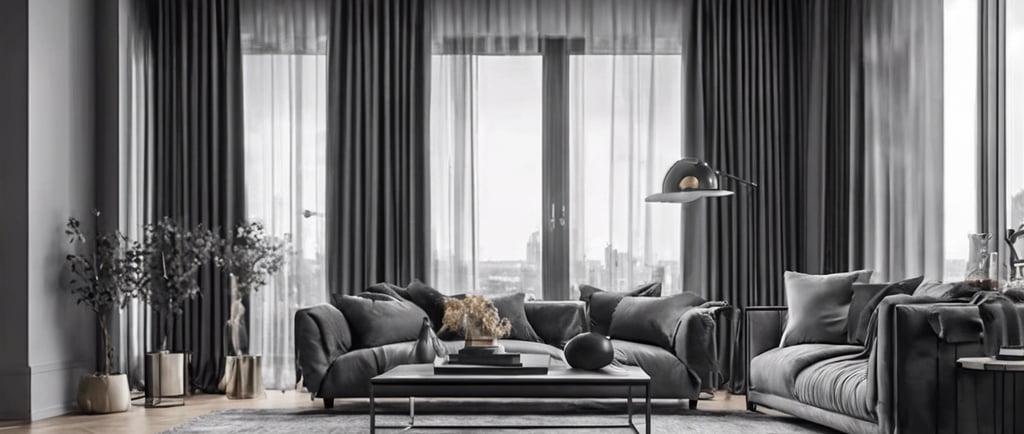Sustainable Style: The Rise of Eco-Friendly Curtain Fabrics
11/24/20245 min read


Understanding Eco-Friendly Fabrics
Eco-friendly curtain fabrics are textiles produced in a manner that is considerate of environmental sustainability. This category encompasses a variety of materials that undergo processes designed to minimize the ecological impact typically associated with conventional textiles. When discussing these fabrics, several terms commonly associated with sustainability arise, including organic, renewable, biodegradable, and recycled.
One prominent material in the realm of eco-friendly curtains is organic cotton. Cultivated without the use of harmful pesticides or synthetic fertilizers, organic cotton is recognized for its minimal environmental footprint. Its cultivation also promotes healthier soil and ecosystems, making it a smart choice for sustainable living.
Hemp is another increasingly popular option for eco-conscious consumers. As one of the fastest-growing plants on Earth, hemp requires significantly less water than conventional crops while also improving soil health. Curtains made from hemp are not only durable but also naturally resistant to mold and UV light, adding functional benefits to their eco-friendly nature.
Linen, derived from the flax plant, also boasts a reputation as an eco-friendly option. The production of linen is less resource-intensive, requiring fewer pesticides and fertilizers. Additionally, linen curtains offer breathability, making them ideal for enhancing indoor air quality while promoting energy efficiency through their temperature-regulating capabilities.
Lastly, recycled polyester represents a remarkable innovation in sustainable textiles. Typically made from discarded plastic bottles, this fabric reduces waste while conserving resources by minimizing the need for new raw materials. Recycled polyester curtains are lightweight and versatile, providing an excellent option for those looking to merge sustainability with style.
In conclusion, eco-friendly curtain fabrics encompass a variety of materials, each offering unique benefits that contribute to environmental sustainability. By opting for fabrics such as organic cotton, hemp, linen, and recycled polyester, consumers can make mindful choices that support ecological health while adorning their spaces beautifully.
The Importance of Sustainable Curtains in Interior Design
Sustainable curtains have emerged as a vital component of contemporary interior design, reflecting a growing awareness of environmental stewardship within home décor. As more homeowners and designers prioritize eco-friendly materials, the shift toward sustainable curtains signifies a commitment to creating healthier living spaces. These curtains are often made from organic fibers and ethically sourced materials, reducing the exposure to harmful toxins that can emit from traditional fabric treatments. This transition not only ensures a safer indoor environment but also aligns with the broader goals of sustainability.
The aesthetic appeal of sustainable curtains further enhances their role in interior design. These fabrics are available in a diverse range of colors and textures, allowing for creative expression while maintaining eco-conscious values. Designers can choose from natural fibers such as hemp, organic cotton, and linen, which offer a distinctive, timeless look that complements various design styles—from minimalistic to bohemian. The versatility of sustainable curtain options enables seamless integration into different aesthetics, contributing to a space that is both stylish and responsible.
Incorporating eco-friendly curtains into a home not only elevates visual appeal but also reinforces a homeowner’s dedication to making conscientious choices. As consumers seek to harmonize style with ethical practices, sustainable curtains serve as a tangible expression of this philosophy. Furthermore, the enduring nature of these fabrics ensures longevity, reducing the need for frequent replacements and thus lowering the overall environmental impact associated with textile production and waste. By choosing sustainable curtains, individuals participate in a collective movement towards a more conscientious and responsible approach to interior design, underscoring that beauty and sustainability can coexist harmoniously in today's modern homes.
Trends Shaping the Eco-Friendly Curtain Market
The eco-friendly curtain fabric market is undergoing significant transformation, driven primarily by the surging consumer demand for sustainable home decor solutions. As awareness regarding environmental issues grows, consumers are increasingly prioritizing products that reflect their values, leading to a heightened interest in eco-friendly materials. This evolving mindset has not only influenced individual purchasing choices but has also compelled manufacturers to innovate and offer sustainable alternatives. Consumers are now keenly interested in understanding the origins of materials, preferring products crafted from organic, recycled, or sustainably sourced fabrics.
Furthermore, the emergence of eco-conscious brands has played a pivotal role in fostering this shift towards sustainability in home textiles. These brands are recognized not only for their commitment to environmentally friendly practices but also for their ability to blend style and functionality with eco-friendly materials. They are developing innovative products that appeal to modern aesthetics while adhering to sustainable principles, such as using natural dyes and incorporating biodegradable materials. This fusion of design and sustainability has resonated well with consumers seeking both beauty and environmental responsibility.
Today’s social media landscape is another crucial factor influencing the rise of eco-friendly curtain fabrics. Influencers and content creators are leveraging platforms like Instagram and Pinterest to showcase stylish home decor that emphasizes environmentally friendly choices. They are driving trends by featuring products that align with a sustainable lifestyle, thus broadening consumer exposure to eco-friendly options. As influencers share their experiences with eco-conscious brands, consumers are provided with relatable contexts for integrating these products into their lives. Innovative designs in curtains, such as those featuring nature-inspired patterns or repurposed materials, are gaining traction, ensuring that sustainability does not compromise aesthetic appeal. In summary, the convergence of consumer demand, brand innovation, and social media advocacy is significantly shaping the landscape of eco-friendly curtain fabrics.
Practical Tips for Choosing and Caring for Eco-Friendly Curtains
As consumers become more environmentally conscious, selecting eco-friendly curtains has gained importance. When opting for sustainable window treatments, start by looking for certifications such as Global Organic Textile Standard (GOTS) or OEKO-TEX. These certifications ensure that the fabrics are produced without harmful chemicals and with environmentally friendly practices. This consideration not only supports sustainability but also ensures the safety of your home environment, especially if you have children or pets.
Understanding the care requirements of eco-friendly fabrics is crucial for maintaining their longevity. Unlike conventional fabrics, eco-friendly options often utilize natural fibers such as organic cotton, linen, or bamboo. Each of these materials may have specific cleaning instructions. For example, while some can be machine washed on a gentle cycle, others might require dry cleaning or hand washing to avoid damaging their fibers. Always check the care label for specific guidance and to prevent unnecessary wear and tear.
Supporting local producers is another vital aspect of choosing eco-friendly curtains. Local artisans often use sustainable methods while minimizing transportation emissions, thus contributing positively to the environment. By purchasing from local sources, you can also foster your community’s economy. Additionally, many local producers provide transparency about their sourcing materials, allowing you to make more informed decisions about the fabrics you choose.
Finally, when it comes to maintenance, implementing simple practices can extend the lifespan of your eco-friendly curtains. Regular dusting or vacuuming to remove dirt accumulation can prevent the fabric from becoming dull over time. When it comes to washing, try using eco-friendly detergents that are free of synthetic chemicals. By following these practical tips when choosing and caring for eco-friendly curtains, you can enhance your living space's aesthetic while minimizing environmental impact.
Curtains&Fabrics
Design,production,sales,service in curtain fabrics&curtians.
Quality
Products
sales01@anytextile.com
+8615968501933
© 2024. SHAOXING LEYAO IMPORT AND EXPORT CO.LTD All rights reserved.
